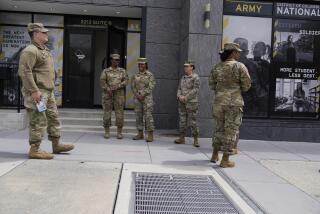Soviet Expert Tells House Panel of Unilateral Weapons Cuts by Kremlin
- Share via
WASHINGTON — A Soviet arms expert, only the second Soviet official ever to testify formally before Congress, said Friday that Moscow is making unilateral cuts in its naval, chemical and short-range nuclear missile forces in addition to the 500,000-troop reduction announced last December.
It is also reconfiguring remaining forces to be more defensively oriented, said Andrei A. Kokoshin, a deputy director of a Soviet institute that studies the United States.
Some of the cuts described by Kokoshin are relatively minor and have been under way for several years. But he invited reciprocal American cuts to sustain the momentum in arms control begun with the 1987 treaty eliminating ground-launched medium-range nuclear missiles.
Rep. Les Aspin (D-Wis.), chairman of the House Armed Services Committee before which Kokoshin appeared, asked whether the unilateral Soviet moves mean that Moscow is skeptical about the chances of success of the new Vienna talks to reduce conventional forces in Europe.
“The negotiations will be very difficult,” Kokoshin replied carefully. He cited the large number of countries involved in the North Atlantic Treaty Organization-Warsaw Pact discussions, and the large number of weapons systems of different characteristics to be balanced against each other.
“Our goals could be met by negotiation or by parallel steps” to reduce the armaments, he said.
With American flags draped behind him, Kokoshin was invited by Aspin to testify as part of what Aspin hopes will be a series of exchanges of U.S. and Soviet experts on military affairs and arms control.
The only previous appearance before Congress by a Soviet official occurred in 1986 when an articulate young diplomat from the embassy here, Vitaly Churkin, testified on the nuclear accident at Chernobyl.
The cuts listed by Kokoshin have been “largely confirmed by the U.S. intelligence community,” a congressional source said in a briefing to the same House committee a day earlier. The cuts, as reported by Kokoshin:
-- Withdrawal of 24 short-range (under 300 miles) nuclear missiles from East Germany, and a halt in programs to modernize these “tactical” weapons. He did not identify the type to be withdrawn, but the Soviets and their allies have more than 300 missiles of two varieties, the Scud and the SS-21, deployed there.
The Soviet move is an obvious effort to maintain pressure on West Germany to further delay approval of a new version of the U.S. Lance short-range missile that would be deployed on its territory and to support Soviet calls for negotiations to eliminate these nuclear systems.
-- Destruction and dismantlement of the Soviet chemical weapon stockpiles. Kokoshin said that the work began this year, as previously promised. U.S. authorities believe that only obsolete and deteriorating weapons are being destroyed, and Aspin noted later that the Soviets have not renounced continued production of chemical weapons.
-- Reductions in naval vessels, particularly in the Far East, where 40 vessels have been taken out of service between 1984 and 1988. Kokoshin was not specific about what kind of ships were removed. The Soviet Pacific fleet includes more than 300 surface combatants and auxiliaries, including two aircraft carriers and almost 100 submarines.
Kokoshin added details on the pace of the major Soviet reductions in East Europe that were announced by Soviet President Mikhail S. Gorbachev at the United Nations last December, and he described reorganization efforts of remaining Soviet forces.
Of the half-million-troop reduction, Kokoshin explained that 450,000 men would come from Soviet forces in the Soviet Union, while 50,000 would come from Soviet forces in East Germany, Czechoslovakia and Hungary, over a two-year period.
In addition, the Soviets will eliminate 10,000 tanks, 8,500 artillery pieces and 800 combat aircraft, also over a two-year period. About 5,300 of the tanks will come from six Soviet tank divisions in three East European nations.
These thinned-out divisions will be equipped with more anti-tank and anti-aircraft weapons, Kokoshin said.
“This changes the standard division from offensive to defensive” orientation, he said.
More to Read
Sign up for Essential California
The most important California stories and recommendations in your inbox every morning.
You may occasionally receive promotional content from the Los Angeles Times.










